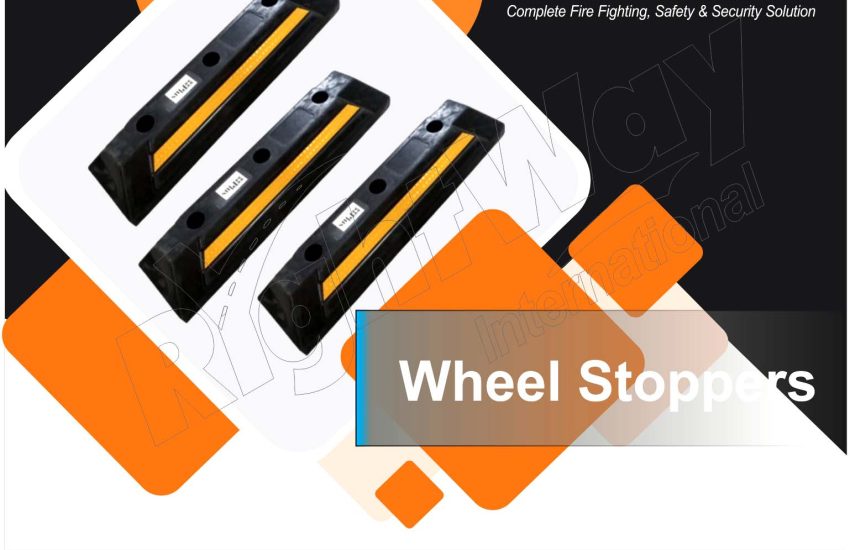Wheel stoppers, also known as wheel chocks, parking blocks, speed breakers, are essential tools used to prevent vehicles from moving unintentionally. These devices are commonly employed in parking lots, garages, and industrial settings to ensure the safety of vehicles and their surroundings. By providing a physical barrier that secures the wheels in place, wheel stopper help prevent accidents, damage, and unauthorized vehicle movement. This article explores the purpose, types, benefits, and best practices associated with wheel stopper.
Purpose of Wheel Stoppers
- Preventing Vehicle Movement
- Accident Prevention: Wheel stopper prevent vehicles from rolling or drifting, which is crucial in preventing accidents in parking lots, garages, and other areas where vehicles are stationary.
- Securing Parked Vehicles: They help keep vehicles in place, reducing the risk of unintended movement that could lead to collisions or damage.
- Protecting Property
- Barrier to Infrastructure: Wheel stopper protect structures, walls, and other infrastructure from being damaged by moving vehicles. They act as a buffer, ensuring that vehicles do not come into contact with sensitive areas.
- Preserving Parking Space: They help delineate parking spaces and ensure that vehicles are parked within designated areas, preventing encroachment and preserving the layout of parking facilities.
- Enhancing Safety
- Pedestrian Safety: By securing vehicles in place, wheel stoppers help create safer environments for pedestrians, reducing the likelihood of accidents involving moving vehicles in parking areas.
- Compliance with Regulations: They assist in meeting safety regulations and standards, particularly in commercial and industrial settings where vehicle safety is paramount.
Types of Wheel Stopper
- Rubber Wheel Stopper
- Durable and Flexible: Made from high-quality rubber, these stoppers are durable and flexible, providing excellent resistance to vehicle impact and environmental conditions.
- Non-Slip Surface: Rubber wheel stoppers often feature a non-slip surface that enhances grip and prevents vehicles from sliding.
- Concrete Wheel Stopper
- Heavy-Duty: Constructed from reinforced concrete, these stoppers are designed for heavy-duty use and provide a robust solution for securing vehicles.
- Long-Lasting: Concrete wheel stoppers are highly durable and can withstand significant wear and tear, making them suitable for high-traffic areas.
- Plastic Wheel Stopper
- Lightweight and Cost-Effective: Made from heavy-duty plastic, these stoppers are lightweight and cost-effective, making them ideal for a wide range of applications.
- Color Options: Plastic wheel stoppers can come in various colors for increased visibility and safety.
- Metal Wheel Stopper
- High Strength: Constructed from steel or aluminum, metal wheel stoppers offer high strength and durability, suitable for industrial and commercial settings.
- Corrosion-Resistant: Many metal wheel stoppers are coated to resist corrosion and extend their lifespan.
Benefits of Wheel Stoppers
- Enhanced Safety
- Accident Reduction: By preventing unintended vehicle movement, wheel stoppers reduce the risk of accidents in parking lots, garages, and other areas.
- Property Protection: They protect property and infrastructure from damage caused by vehicles.
- Improved Parking Efficiency
- Space Management: Wheel stoppers help maintain orderly parking by delineating spaces and ensuring vehicles remain within designated areas.
- Ease of Use: They provide a simple and effective solution for managing vehicle movement and parking.
- Durability and Low Maintenance
- Long-Lasting Materials: Wheel stoppers are made from durable materials that withstand heavy use and require minimal maintenance.
- Cost-Effective: Many types of wheel stoppers are cost-effective and provide long-term value.
Best Practices for Using Wheel Stopper
- Proper Installation
- Secure Placement: Ensure wheel stoppers are securely installed in the correct positions to effectively prevent vehicle movement. Follow manufacturer guidelines for installation.
- Align with Parking Spaces: Place wheel stopper in alignment with parking space boundaries to maximize their effectiveness and ensure vehicles stay within designated areas.
- Regular Inspection and Maintenance
- Check for Damage: Regularly inspect wheel stopper for signs of damage or wear and replace any that are broken or degraded.
- Clean Surface: Keep the surface of wheel stoppers clean to maintain visibility and effectiveness.
- Compliance with Regulations
- Adhere to Standards: Ensure that wheel stopper meet local safety regulations and standards for their intended use.
Conclusion
Wheel stopper are vital components of vehicle safety and parking efficiency. By preventing unintended vehicle movement, protecting property, and enhancing safety, these devices play a crucial role in maintaining order and safety in various settings. Understanding the different types of wheel stopper and following best practices for their installation and maintenance can help ensure their effectiveness and contribute to a safer and more organized environment.


